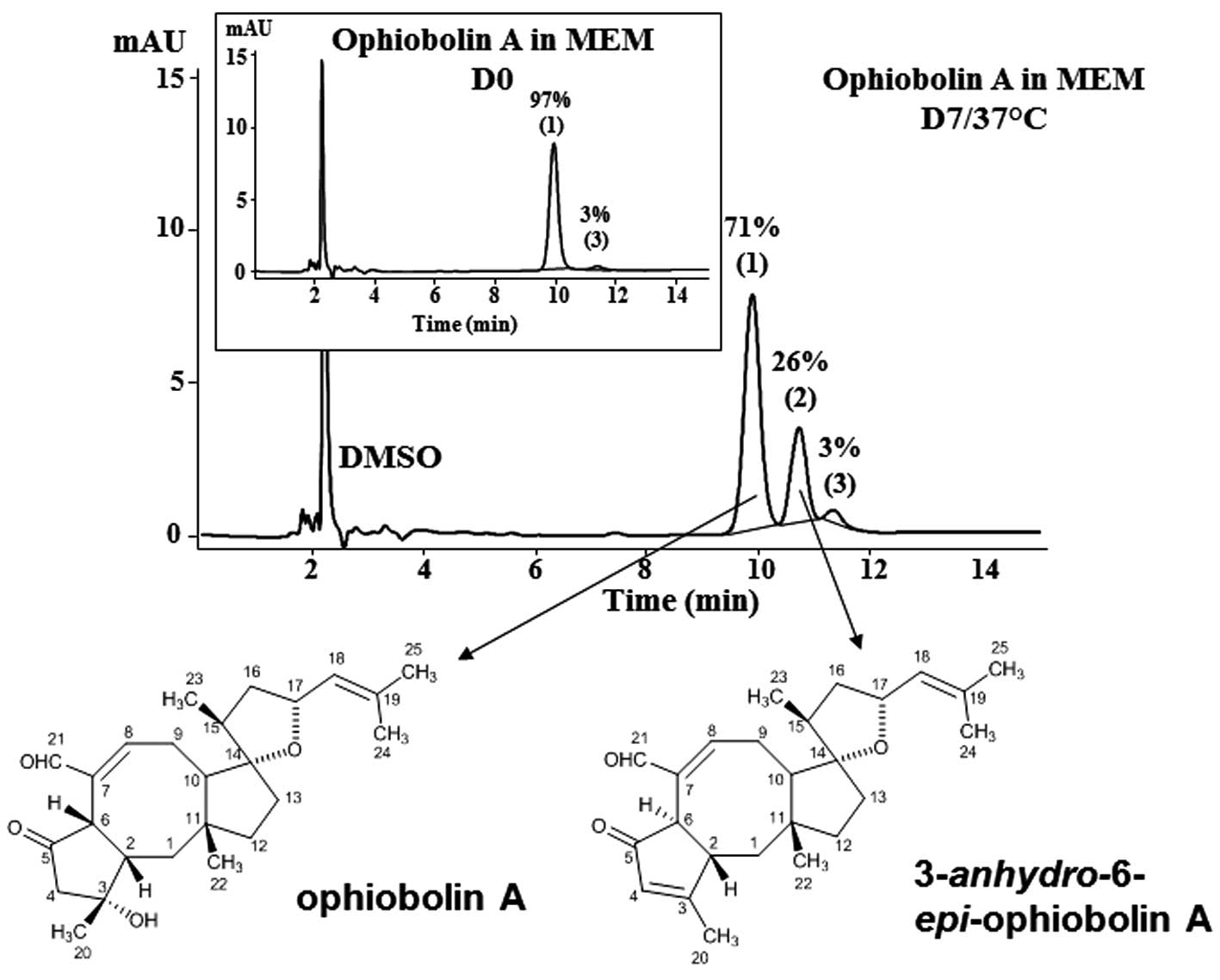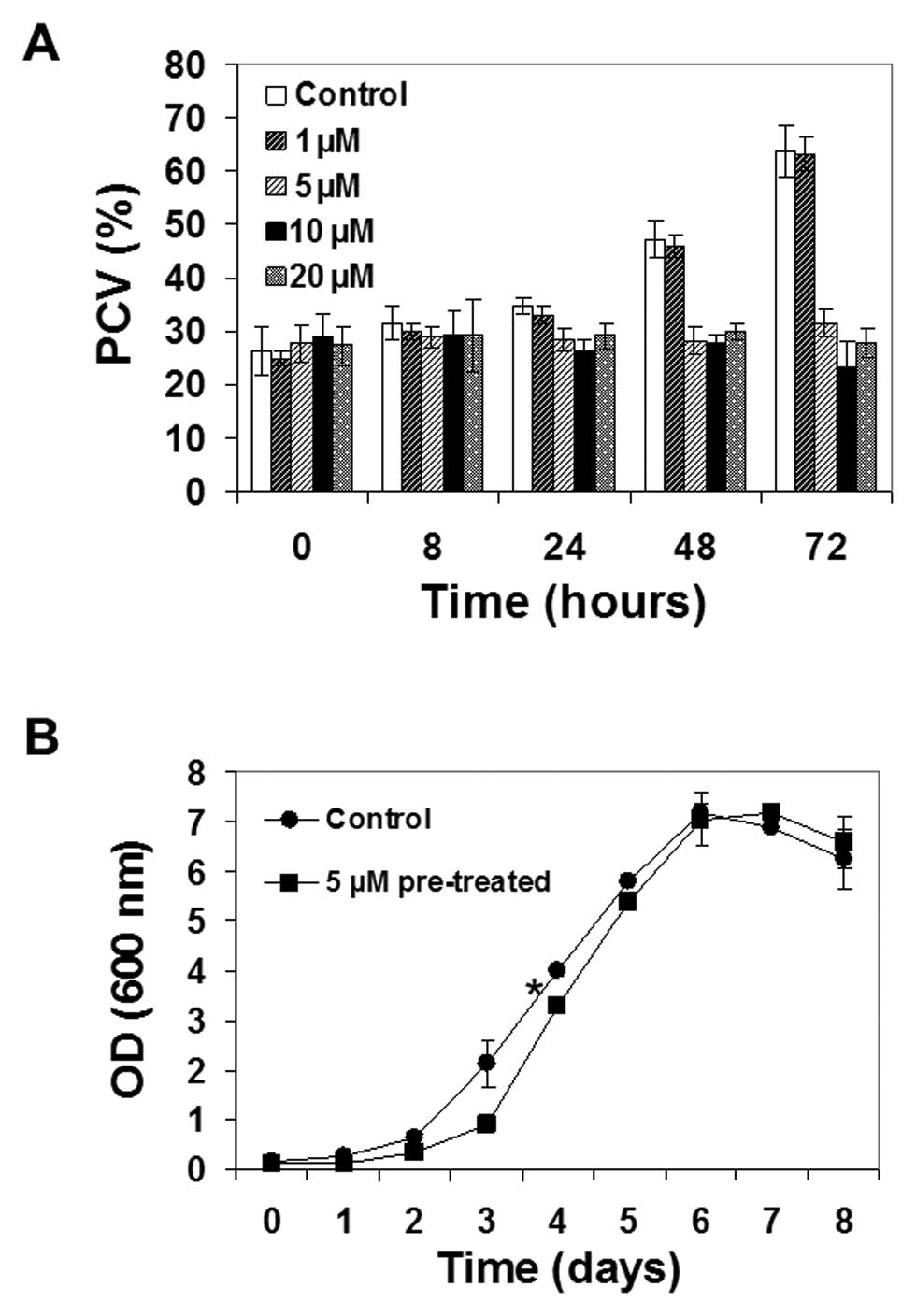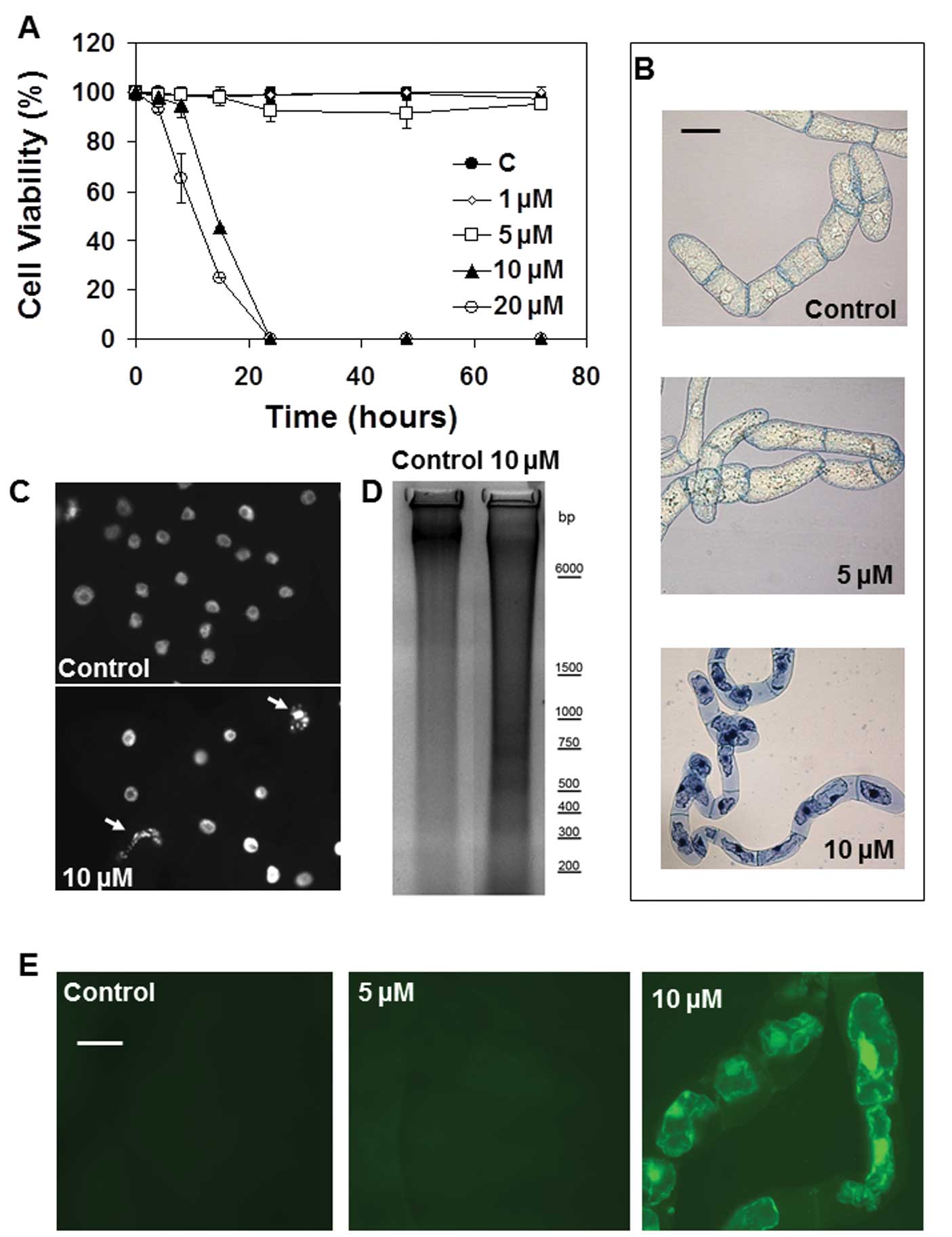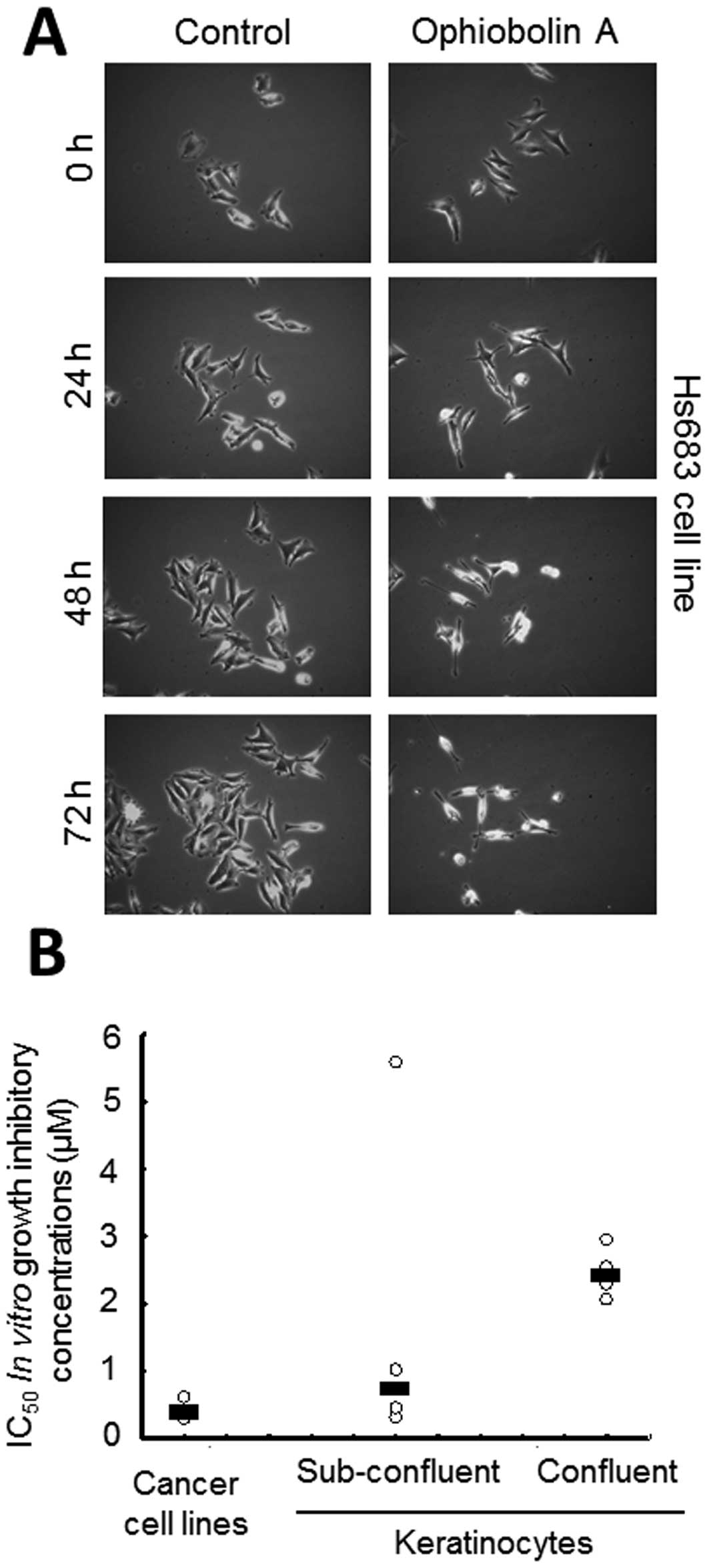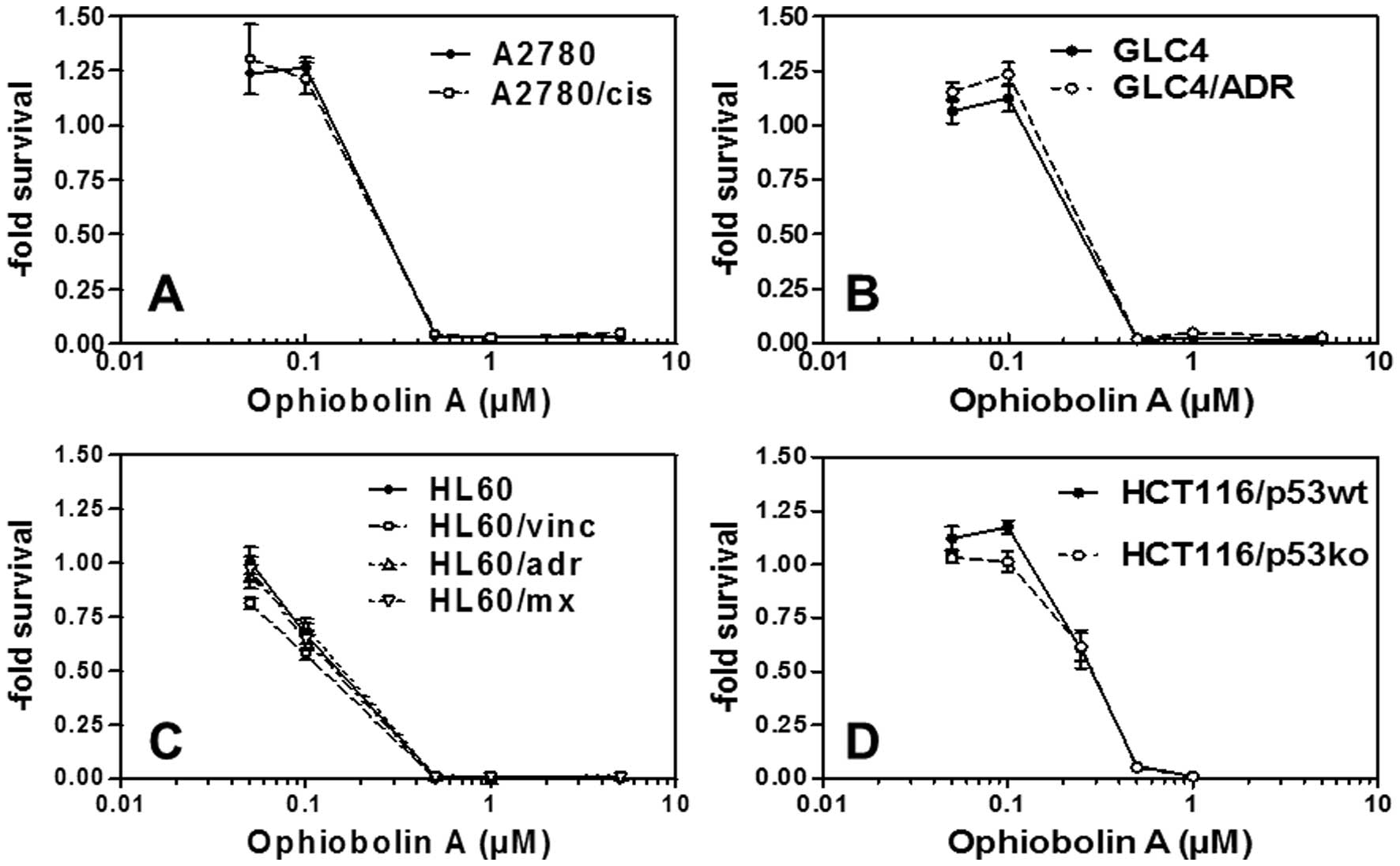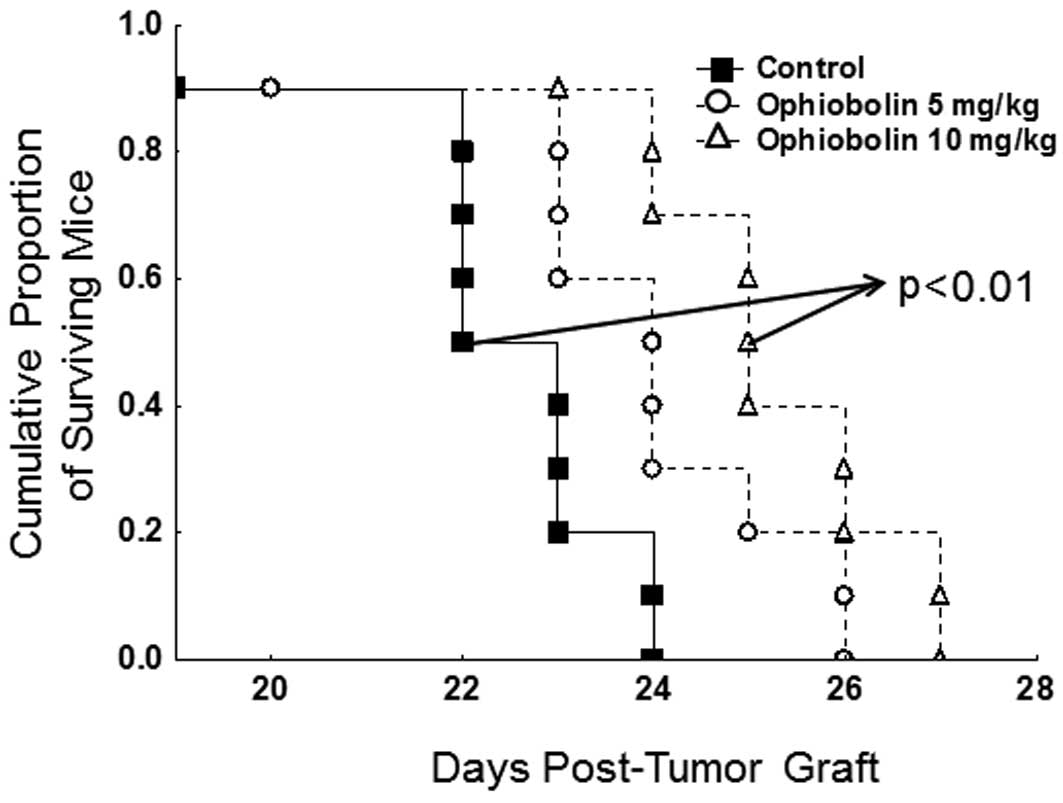|
1.
|
Au TK, Chick WSH and Leung PC: The biology
of ophiobolins. Life Sci. 67:733–742. 2000. View Article : Google Scholar
|
|
2.
|
Canonica L, Fiecchi A, Kienle MG and Scala
A: The constitution of cochliobolin. Tetrahedron Lett.
11:1211–1218. 1966. View Article : Google Scholar
|
|
3.
|
Nozoe S, Morisaki M, Tsuda K, Takahashi N,
Tamura S, Ishibashi K and Shirasaka M: The structure of ophiobolin,
a C25 terpenoid having a novel skeleton. J Am Chem Soc.
87:4968–4970. 1965. View Article : Google Scholar : PubMed/NCBI
|
|
4.
|
Arai M, Niikawa H and Kobayashi M:
Marine-derived sesterterpenes, ophiobolins, inhibit biofilm
formation of Mycobacterium species. J Nat Med. 67:271–275.
2013. View Article : Google Scholar : PubMed/NCBI
|
|
5.
|
Evidente A, andolfi A, Cimmino A, Vurro M,
Fracchiolla M and Charudattan R: Herbicidal potential of
ophiobolins produced by Drechslera gigantea. J Agric Food
Chem. 54:1779–1783. 2006. View Article : Google Scholar : PubMed/NCBI
|
|
6.
|
De Vries-van Leeuwen IJ,
Kortekaas-Thijssen C, Nzigou Mandouckou JA, Kas S, Evidente A and
de Boer AH: Fusicoccin-A selectively induces apoptosis in tumor
cells after interferon-alpha priming. Cancer Lett. 293:198–206.
2010.PubMed/NCBI
|
|
7.
|
Shen X, Krasnoff SB, Lu SW, Dunbar CD,
O'Neal J, Turgeon BG, Yoder OC, Gibson DM and Hamann MT:
Characterization of 6-epi-3-anhydroophiobolin B from
Cochliobolus heterostrophus. J Nat Prod. 62:895–897.
1999.
|
|
8.
|
Yang T, Lu Z, Meng L, Wei S, Hong K, Zhu W
and Huang C: The novel agent ophiobolin O induces apoptosis and
cell cycle arrest of MCF-7 cells through activation of MAPK
signaling pathways. Bioorg Med Chem Lett. 22:579–585. 2012.
View Article : Google Scholar : PubMed/NCBI
|
|
9.
|
Nagata T, Nemoto Y and Hasezawa S: Tobacco
BY-2 cell line as the ‘HeLa’ cell in the cell biology of higher
plants. Int Rev Cytol. 132:1–30. 1992.
|
|
10.
|
Vacca RA, de Pinto MC, Valenti D,
Passerella S, Marra E and De Gara L: Reactive oxygen species
production, impairment of glucose oxidation and cytosolic ascorbate
peroxidase are early events in heat-shock-induced programmed cell
death in tobacco BY-2 cells. Plant Physiol. 134:1100–1112. 2004.
View Article : Google Scholar
|
|
11.
|
Pellny TK, Locato V, Vivancos PD, Markovic
J, De Gara L, Pallardó FV and Foyer CH: Pyridine nucleotide cycling
and control of intracellular redox state in relation to poly
(ADP-ribose) polymerase activity and nuclear localization of
glutathione during exponential growth of Arabidopsis cells in
culture. Mol Plant. 2:442–456. 2009. View Article : Google Scholar
|
|
12.
|
Locato V, Balestrazzi A, De Gara L and
Carbonera D: Reduced expression of top1b gene induces
programmed cell death and alters ascorbate metabolism in Daucus
carota cultured cells. J Exp Bot. 57:1667–1676. 2006.
|
|
13.
|
Locato V, Gadaleta C, De Gara L and de
Pinto MC: Production of reactive species and modulation of
antioxidant network in response to heat shock: a critical balance
for cell fate. Plant Cell Environ. 31:1606–1619. 2008. View Article : Google Scholar : PubMed/NCBI
|
|
14.
|
Houot V, Etienne P, Petitot AS, Barbier S,
Blein JP and Suty L: Hydrogen peroxide induces programmed cell
death features in cultured tobacco BY-2 cells in a dose-dependent
manner. J Exp Bot. 52:1721–1730. 2001. View Article : Google Scholar : PubMed/NCBI
|
|
15.
|
Edwards K, Johnstone C and Thompson A: A
simple and rapid method for the preparation of plant genomic DNA
for PCR analysis. Nucleic Acids Res. 19:13491991. View Article : Google Scholar : PubMed/NCBI
|
|
16.
|
de Pinto MC, Paradiso A, Leonetti P and De
Gara L: Hydrogen peroxide, nitric oxide and cytosolic ascorbate
peroxidase at the crossroad between defense and cell death. Plant
J. 48:784–795. 2006.PubMed/NCBI
|
|
17.
|
Royall JA and Ischiropoulos H: Evaluation
of 2′,7′-dichlorofluorescin and dihydrorhodamine 123 as fluorescent
probes for intracellular H2O2 in cultured
endothelial cells. Arch Biochem Biophys. 302:348–355. 1993.
|
|
18.
|
Le Calvé B, Lallemand B, Perrone C,
Lenglet G, Depauw S, Van Goietsenoven G, Bury M, Vurro M, Herphelin
F, andolfi A, Zonno MC, Mathieu V, Dufrasne F, Van Antwerpen P,
Poumay Y, David-Cordonnier MH, Evidente A and Kiss R: In vitro
anti-cancer activity, toxicity and structure-activity relationships
of phyllostictine A, a natural oxazatricycloalkenone produced by
the fungus Phyllosticta cirsii. Toxicol Appl Pharmacol. 254:8–17.
2011.
|
|
19.
|
Atanasova G, Jans R, Zhelev N, Mitev V and
Poumay Y: Effects of the cyclin-dependent kinase inhibitor CYC202
(R-roscovitine) on the physiology of cultured human keratinocytes.
Biochem Pharmacol. 70:824–836. 2005. View Article : Google Scholar : PubMed/NCBI
|
|
20.
|
Minner F, Herphelin F and Poumay Y:
Epidermal cells methods and protocols. Methods in Molecular
Biology. 2nd edition. Turksen K: Humana Press; New York, NY: 585.
pp. 71–82. 2010, PubMed/NCBI
|
|
21.
|
Janssen T, Darro F, Petein M, Raviv G,
Pasteels JL, Kiss R and Schulman CC: In vitro characterization of
prolactin-induced effects on proliferation in the neoplastic LNCaP,
DU145 and PC-3 models of the human prostate. Cancer. 77:144–149.
1996. View Article : Google Scholar : PubMed/NCBI
|
|
22.
|
McGrath T and Center MS: Mechanisms of
multidrug resistance in HL60 cells: evidence that a surface
membrane protein distinct from P-glycoprotein contributes to
reduced cellular accumulation of drug. Cancer Res. 48:3959–3963.
1988.
|
|
23.
|
Heffeter P, Pongratz M, Steiner E, Chiba
P, Jakupec MA, Elbling L, Marian B, Körner W, Sevelda F, Micksche
M, Keppler BK and Berger W: Intrinsic and acquired forms of
resistance against the anticancer ruthenium compound KP1019
(indazolium trans-[tetrachlorobis(1H-indazole)ruthenate (III)
(FFC1A4)). J Pharmacol Exp Ther. 312:281–289. 2005.PubMed/NCBI
|
|
24.
|
Zijlstra JG, de Vries EG and Mulder NH:
Multifactorial drug resistance in an adriamycin-resistant human
small cell lung carcinoma cell line. Cancer Res. 47:1780–1784.
1987.PubMed/NCBI
|
|
25.
|
Heffeter P, Jakupec MA, Korner W, Chiba P,
Pirker C, Dornetshuber R, Elbling L, Sutterlüty H, Micksche M,
Keppler BK and Berger W: Multidrug-resistant cancer cells are
preferential targets of the new antineoplastic lanthanum compound
KP772 (FFC24). Biochem Pharmacol. 73:1873–1886. 2007. View Article : Google Scholar : PubMed/NCBI
|
|
26.
|
Bunz F, Fauth C, Speicher MR, Dutriaux A,
Sedivy JM, Kinzler KW, Vogelstein B and Lengauer C: Targeted
inactivation of p53 in human cells does not result in aneuploidy.
Cancer Res. 62:1129–1133. 2002.PubMed/NCBI
|
|
27.
|
Delbrouck C, Doyen I, Belot N,
Decaestecker C, Ghanooni R, de Lavareille A, Kaltner H, Choufani G,
Danguy A, Vandenhoven G, Gabius HJ, Hassid S and Kiss R: Galectin-1
is overexpressed in nasal polyps under budesonide and inhibits
eosinophil migration. Lab Invest. 82:147–158. 2002. View Article : Google Scholar : PubMed/NCBI
|
|
28.
|
Mégalizzi V, Mathieu V, Mijatovic T,
Gailly P, Debeir O, De Neve N, Van Damme M, Bontempi G, Haibe-Kains
B, Decaestecker C, Kondo Y, Kiss R and Lefranc F: 4-IBP, a sigma1
receptor agonist, decreases the migration of human cancer cells,
including glioblastoma cells, in vitro and sensitizes them in vitro
and in vivo to cytotoxic insults of proapoptotic and proautophagic
drugs. Neoplasia. 9:358–369. 2007.
|
|
29.
|
Mathieu V, Le Mercier M, De Neve N,
Sauvage S, Gras T, Roland I, Lefranc F and Kiss R: Galectin-1
knockdown increases sensitivity to temozolomide in a B16F10 mouse
metastatic melanoma model. J Invest Dermatol. 127:2399–2410. 2007.
View Article : Google Scholar : PubMed/NCBI
|
|
30.
|
de Pinto MC, Locato V and De Gara L: Redox
regulation in plant programmed cell death. Plant Cell Environ.
35:234–244. 2012.PubMed/NCBI
|
|
31.
|
Paradiso A, de Pinto MC, Locato V and De
Gara L: Galactone-γ-lactone-dependent ascorbate biosynthesis alters
wheat kernel maturation. Plant Biol. 14:652–658. 2012.
|
|
32.
|
Mur LAJ, Kenton P, Lloyd AJ, Ougham H and
Prats E: The hypersensitive response; the centenary is upon us but
how much do we know? J Exp Botany. 59:501–520. 2008. View Article : Google Scholar : PubMed/NCBI
|
|
33.
|
Dodds PN and Rathjen JP: Plant immunity:
towards an integrated view of plant-pathogen interactions. Nat Rev
Genet. 11:539–548. 2010. View Article : Google Scholar : PubMed/NCBI
|
|
34.
|
Gechev TS and Hille J: Hydrogen peroxide
as a signal controlling plant programmed cell death. J Cell Biol.
168:17–20. 2005. View Article : Google Scholar : PubMed/NCBI
|
|
35.
|
Levine A, Tenhaken R, Dixon R and Lamb C:
H2O2 from the oxidative burst orchestrates
the plant hypersensitive disease resistance response. Cell.
79:583–593. 1994.
|
|
36.
|
Lachaud C, Da Silva D, Amelot N, Béziata
C, Briére C, Cotelle V, Graziana A, Grata S, Mazars C and Thuleau
P: Dihydrosphingosine-induced programmed cell death in tobacco BY-2
cells is independent of H2O2 production. Mol
Plant. 4:310–318. 2011. View Article : Google Scholar : PubMed/NCBI
|
|
37.
|
De Gara L, Locato V, Dipierro S and de
Pinto MC: Redox homeostasis in plants. The challenge of living with
endogenous oxygen production. Respir Physiol Neurobiol. 173(Suppl):
S13–S19. 2010.PubMed/NCBI
|
|
38.
|
Fujiwara H, Matsunaga K, Kumagai H,
Ishizuka M and Ohizumi Y: Ophiobolin A, a novel apoptosis-inducing
agent from fungus Strain f-7438. Pharm Pharmacol Commun. 6:427–431.
2000. View Article : Google Scholar
|
|
39.
|
Shen L, Kondo Y, Ahmed S, Boumber Y,
Konishi K, Guo Y, Chen X, Vilaythong JN and Issa JP: Drug
sensitivity prediction by CpG island methylation profile in the
NCI-60 cancer cell line panel. Cancer Res. 67:11335–11343. 2007.
View Article : Google Scholar : PubMed/NCBI
|
|
40.
|
Dittmann LM, Danner A, Gronych J, Wolter
M, Stühler K, Grzendowski M, Becker N, Bageritz J, Goidts V, Toedt
G, Felsberg J, Sabel MC, Barbus S, Reifenberger G, Lichter P and
Tews B: Downregulation of PRDX1 by promoter hypermethylation is
frequent in 1p/19q-deleted oligodendroglial tumours and increases
radio- and chemosensitivity of Hs683 glioma cells in vitro.
Oncogene. 31:3409–3418. 2012. View Article : Google Scholar : PubMed/NCBI
|
|
41.
|
de Lange J, Ly LV, Lodder K, Verlaan-de
Vries M, Teunisse AF, Jager MJ and Jochemsen AG: Synergistic growth
inhibition based on small-molecule p53 activation as treatment for
intraocular melanoma. Oncogene. 31:1105–1116. 2012.PubMed/NCBI
|
|
42.
|
Yoshida N, Koizumi M, Adachi I and
Kawakami J: Inhibition of P-glycoprotein-mediated transport by
terpenoids contained in herbal medicines and natural products. Food
Chem Toxicol. 44:2033–2039. 2006. View Article : Google Scholar : PubMed/NCBI
|
|
43.
|
Leung PC, Taylor WA, Wang JH and Tipton
CL: Ophiobolin A. A natural product inhibitor of calmodulin. J Biol
Chem. 259:2742–2747. 1984.PubMed/NCBI
|
|
44.
|
Leung PC, Taylor WA, Wang JH and Tipton
CL: Role of calmodulin inhibition in the mode of action of
ophiobolin A. Plant Physiol. 77:303–308. 1985. View Article : Google Scholar : PubMed/NCBI
|
|
45.
|
Kahl CR and Means AR: Regulation of cell
cycle progression by calcium/calmodulin-dependent pathways. Endocr
Rev. 24:719–736. 2003. View Article : Google Scholar : PubMed/NCBI
|



